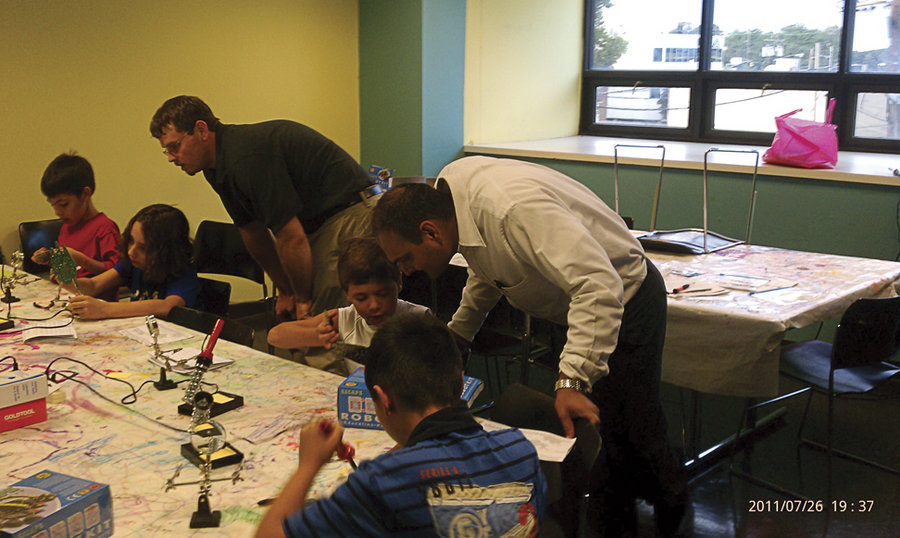Parents looked on with awe as eleven-year-old Martin Lee and ten-year-old Phoebe Chang solved complex multiplication and division problems in a matter of seconds during the conclusion of the Accel Learning speed math and computer science courses held on Nov. 29 at the Secaucus community center. During a demonstration for Parent Night, Accel Learning Director Amish Bhavsar led the group of parents through some of the speed math shortcuts taught in that course and also showed examples of games that were created by kids in the computer science course.
“I like that we get to make games.” Allyson Tarifa
____________
An interest in extra-curricular activities
A Secaucus resident with two children, Bhavsar launched Accel Learning with robotics and speed math courses after students he tutors complained that their school studies weren’t challenging enough.
“They felt a little bored in school. [The students said] ‘They are not teaching us anything new,’” said Bhavsar. “We give them exposure to things they would never learn during the course of their education.”
Some of the parents echoed Bhavsar’s sentiments.
“The school doesn’t offer extracurricular programs like this,” said Jean-Pierre Alarcon. His seven-year-old son Thomas and six-year-old daughter Isabel were both enrolled in the computer science course. Thomas also took the robotics course offered over the summer.
“I was a fish and I had to get the worm,” said Thomas Alarcon about the best part of the computer science course.
“We wanted [Allyson] to be proficient in math and science,” said William Tarifa, father of nine-year-old Allyson who took the computer science course. Allyson is a fourth grade student at Clarendon.
“I like that we get to make games,” said Allyson Tarifa.
“We wish the school would offer more science projects,” said Yomaira Tarifa, Allyson’s mother.
Solving 23×11 in a second
Parents were noticeably impressed with the math shortcuts shared during the speed math demonstration. A fifth grader at Clarendon, Chang solved 1234 x 11 without any hesitation or need to do long form multiplication.
“I thought it might be a good thing for her. To [do math] the easier way rather than the long way,” said Trisha Chang, her mother.
Throughout the speed math course, students learn mental shortcuts to solve specific types of math problems such as squaring two-digit numbers or dividing three digit numbers by 9.
“At a very early age, kids already start using a calculator,” said Bhavsar. “What happens in the process is that their mind stops doing any of the calculation because of inertia…[Through speed math] kids are given training that can help them calculate seemingly difficult [math] questions in their mind,” said Bhavsar. “We cover what is relevant to them.”
Animated fish, bricks, and Pac Man
Eight-year-old Vincent Pizzuto wasn’t satisfied with the yellow, pie-shaped Pac Man from the Atari era when he built his own version of the game in the computer science course. He wanted to replace the Pac Man character with an Angry Birds figure from the popular game application available on smart phones.
“Instead of Pac Man he wanted to have an angry bird going around,” said Bhavsar. “We said, ‘Absolutely, you can do that!’ We showed him how to build an angry bird and have it take on the role of Pac Man.”
The computer science course uses Scratch, a visual programming tool developed by M.I.T. Mitchel Resnick, a professor of learning research at M.I.T.’s Media Lab who helps run the Scratch project, said that Scratch is effective with children because it fosters collaboration according to a recent article in the New York Times. In the article, Resnick said that a third of Scratch projects, more than 600,000, are remixes, or kids building on someone else’s work. The games created by Accel Learning are among those that are hosted on the Scratch web site.
“It is pretty drag and drop,” said Bhavsar. By choosing specific commands, kids can change colors, characters, background, music, and determine what factors calculate the score.
“At the end of the day, we found that students have gone even further to create more stuff on their own,” said Bhavsar.
Future courses on how to build Xbox360 games
The next series of Accel Learning courses begins Spring of 2012 and will include a course on how to build games for Xbox360. It will also include Robotics where students learn the basics of electronics and mechanics and build their own fully autonomous robot. Bhavsar eventually plans to expand the course offerings to Jersey City and seeks an arrangement similar to the one he has with the town of Secaucus.
“We do this more of a passion to teach kids then as a business,” said Bhavsar. In addition to Accel Learning both Bhavsar and Rodriguez have full-time jobs as IT professionals.
Adriana Rambay Fernández may be reached at afernandez@hudsonreporter.com.
